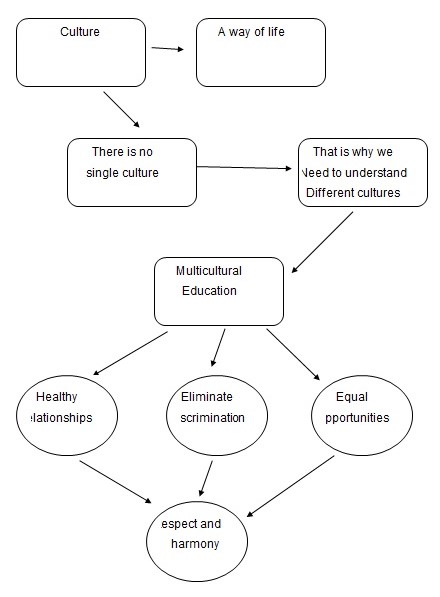
What is Culture?
The word culture is defined in numerous ways. Some may define culture as the clothes they wear, the food they eat, the language they speak, or the religion they practice. It is true that all that is part of a particular culture, but is that all? Would culture include the way we think? The way we treat others? The way we function in our society? The jobs we prefer? The things we learn at school? Hence, culture is a way of life. It is the way we think and perceives things around us. Although the language, religion, race, geographic location, and social organization are a part of the culture, it does not end there.
Multicultural Education
We live in a world with a diverse range of cultures. Being humans, we have a lot in common but we also differ greatly. When it comes to culture, the little things matter. We find all kinds of people at work, out on the streets, in our neighborhoods, and our schools; and that is where a child creates a mindset that is with him/her for the rest of their life. This is where the concept of multicultural education comes in. it is an approach to education in which an institution’s curriculum, teaching methods, and ideologies are designed and put into action in the way that all children accept and appreciate the diversity around them and are aware of their contributions to the society. With multicultural education, children experience different flavors of the world at a “make or break” age. If the children experience and learn that the world inhabits many types of people, they grow up to understand and function effectively in a world that is experiencing rapid globalization; where all cultures intermingle and work together and cultural boundaries are blurred. (Hanley, 1999)
Multicultural education revolves around certain principles. These principles are based on the findings of the Multicultural Education Consensus Panel. These principles and guidelines help policy-making and teaching methodology in a diverse learning environment. The findings revolve around creating a healthy learning and interactive environment in multicultural educational institutions. These principles will be briefly discussed in this essay.
The principles are broadly divided into teacher learning, student learning, intergroup relations, school governance, organization, and equity and assessment. (Banks, 2001)
Teacher Learning
Teachers need to be trained through development programs that enable them to understand and function well within the ethnically diverse students and understand them better.
Student Learning
Equal opportunities should be given to all students in all fields; academic and extracurricular and foster healthy relationships through teamwork. Students need to be taught that knowledge is a combination of experiences and social, political, and economic contexts in which they exist and function.
Intergroup Relations
Good communication is the key here. With group work, students can understand one another better and understand the negative aspects of discrimination and stereotyping. Teachers should help students practice healthy interaction so that no ethnic fear and anxiety exists.
School Governance, Organization, and Equity
Decision-making should be shared and fair. Just allocation of equity should be practiced regardless of the location or population/status of schools.
Assessment
Teachers should adopt multiple culturally sensitive methods to assess complex cognitive and social skills. (Banks, 2001)
Can it make a Difference?
As we can see, multicultural education can help eliminate racism, ethnic issues, fear and anxiety, and biases. With proper training, teachers will be well equipped with the knowledge of different ethnic settings within the country. Good training will also ensure a non-bias attitude towards the students and the policies made on the basisbased on of the above principles will not be discriminatory. Apart from that, students will learn and grow up in a diverse environment. They will be taught about the issues different races face and how discrimination is widening the gap between races. With healthy interaction and group activity, students will grow into smart, comfortable, and open-minded individuals who would know that ethnic discrimination, stereotyping and other biases are unacceptable and immature. Thus, if we do this today, we can ensure a much more harmonious and open-minded world tomorrow. (Lynch)
Before my study, my conceptions of multicultural education were limited. I did not understand clearly how it can potentially make such a big difference. The advantages I thought of were limited to different ethnic groups being exposed to each other and getting a chance to interact in a controlled environment. But now I see that the concept addresses issues beyond this n move into governance and policymaking. I also see the importance of teacher training and development, which I had not realized before. Without a proper understanding of the base issues and the history of ethnic relations, a teacher cannot foster a proper healthy diverse learning environment in their class. Also, if we practice these principles effectively today we can make a big difference tomorrow.
I have come to realize that training teachers through proper development programs are a vital part of adopting multicultural education in its true sense. As a teacher, I would make it my initiative to learn more about the different ethnic groups present in our schools, their backgrounds, the negative issues they face, and how to address those issues. This would help me understand my students better, without which making them learn would be impossible. So, to train and develop a positive attitude in the students’ minds, it is important to first understand the issues myself.
References
Banks, J. A. (2001). New Horizons. Web.
Hanley, M. S. (1999). The Scope of Multicultural Education. Web.
Lynch, J. Multicultural Education: Principles and Practice (Routledge Education Books) (Paperback). Routledge & Kegan Paul Books Ltd.